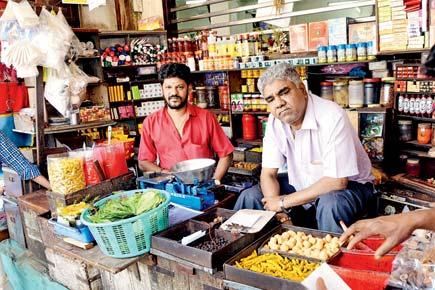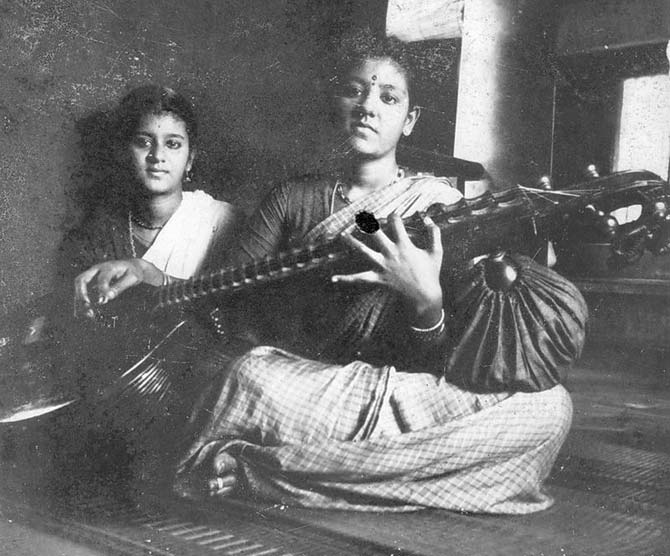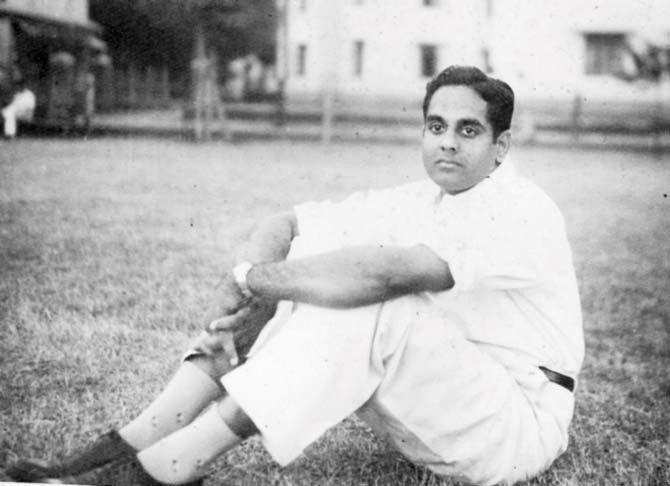Celebrating Pongal and the Thyagaraja music festival in Matunga, three Iyer families share stories of immigration and integration

The Pillai brothers

The Pillai brothers, Krishnan and Shaktivel, at their 80-year-old shop Madras Paan, which stocks provisions typically catering to Matunga’s Tamil community. Pic/Sayed Sameer Abedi
 Some neighbours are more special than others. Like ours in Matunga, skirting the Dadar Parsi Colony where we used to visit grandparents. Overdosing on Bawa boom, my cousins and I would slip away next door for quieter fun. We’d trail friends through leafy lanes as one reported for dance class, another rehearsed for a Shanmukhananda concert (without knowing Tamilians in 1960s-70s Bombay, you're forgiven for thinking that hall only hosted Filmfare Awards). Practices done, we dashed off for games of Chain Cook to Five Gardens, whose soft grass lawns weren’t yet heaped with hard plastic play mazes.
Some neighbours are more special than others. Like ours in Matunga, skirting the Dadar Parsi Colony where we used to visit grandparents. Overdosing on Bawa boom, my cousins and I would slip away next door for quieter fun. We’d trail friends through leafy lanes as one reported for dance class, another rehearsed for a Shanmukhananda concert (without knowing Tamilians in 1960s-70s Bombay, you're forgiven for thinking that hall only hosted Filmfare Awards). Practices done, we dashed off for games of Chain Cook to Five Gardens, whose soft grass lawns weren’t yet heaped with hard plastic play mazes.
ADVERTISEMENT

Carnatic virtuoso Kalyani Sharma waits her turn while her sister Vallibai Mahadevan plays the veena in 1962
I was mesmerised again at Shanmukhananda last month by a virtuoso performance of my friend Hema Ankolkar's musician mother. In the programme composed and conducted by her, Kalyani Sharma’s pure energy shook the stage. She and her students dedicated an incredible inaugural edition of Mahaswamy Pancharathna Aradhanai to the Kanchi Paramacharya. The show will continue yearly in the tradition of the Thyagaraja festival.

Aeronautics engineer Narayana Sarma from Trivandrum in a Matunga garden in 1957
"I was fortunate in this dream locality,” says Subramani N Sharma, the Carnatic singer’s husband. His ancestors migrated over two centuries to Trivandrum from Kadayam village in Thirunelveli. “I did not choose Matunga, it chose me,” says the textile chemist who arrived to work in the printing department of city mills from 1952 to 1992. “As new entrants do, I stayed with accommodative relatives. Life in Matunga is convenient and calm. My wife too could pursue her profession of teaching the veena in this culture."
Churned by a colourful cauldron of immigrants from Thirunelveli and Tanjore, Matunga is indisputably 'mini Madras' despite Kutchis packing large pockets of it today. It claims a dual etymology. The word Matang is Marathi for 'elephant' — this was where Raja Bhimdev's 14th-century elephant stables were. The other legend has it that sage Matang of the Ramayana rested here after wandering the subcontinent.
What was this swampy bog of a village-cum-European military outpost like before the English revamped it as 'garden suburb' and the South swept in? Once barracks shifted to Ahmednagar, Matunga was deserted by 1835. The 1896 Plague forced the Brits to implement the Dadar-Matunga-Wadala-Sion schemes, decongesting the island city. By 1900 the Bombay City Improvement Trust converted 440 paddy field acres for Dadar and Matunga. Two-to-three storey Art Deco apartment blocks sprang up in the 1920s, sprouting ample balconies and ventilation. The master plan pencilled in parks and public buildings like Victoria Jubilee Technical Institute and South Indian Education Society campuses. The Tramway Company extended services to the area approached by just constructed Mohammedali Road which linked to broad, electric lamp-lit Kingsway Avenue.
Within its neat grid of right-angled, tree-lined roads, Matunga boasted institutions like South Indian Bhajana Samaj and Thyagaraja Sabha from 1931, much before Shanmukhananda or Tamil Sangam in Sion. The Matunga temple had the most popular priest for an all-important rite: the annual thread changing ceremony for boys. Interestingly, S Panchapakesan, associated with the Shankara Mattham, describes how devotees march across Matunga at dawn sonorously chanting the Taittiriya Upanishad in a ritual that concludes the December-January month of Margazhi.
Few localities stoke one’s sense of smell quite as dramatically. Guru K Harikrishna of Sri Rajarajeswari Bharatha Natya Kala Mandir evokes a swirl of delectable scents: “Step into Matunga and your nose will be hit by the aroma of filter coffee before it inhales the fresh ghee coating dosas. Finally, the fragrance of malligapu (mogra) offerings to the Lord... and then the sound section takes over, with Vedic chants, classical beats.” On cue, the rhythmic Tha-tai-tai-tha of ghungrooed feet reaches us as he ushers me into Bombay’s oldest school of Bharat Natyam. Founded in 1945 by his grandfather, Guru TP Kuppiah Pillai, as a dynamic centre of Indian resurgence, it propagated polyglot lyrics to fan nationalist fervour.
“Learning dance added a definite different dimension to the girl child’s education,” Harikrishna remarks. Every room of this little school on Shradhanand Road heaves with history. In the corner beside us would sit its patron, the patriot writer E Krishna Iyer. At 85, Harikrishna’s father, Guru K Kalyanasundaram, is Maharashtra’s oldest living Sangeet Naatak Akademi award winner for Bharat Natyam. Harikrishan declares, “Art in Matunga still attracts young minds.”
At 26, Narayana P Sarma also came to Matunga from Trivandrum. Grandson of a magistrate honoured as Diwan Peshkar by the Maharaja of Travancore, the aeronautical engineer landed a job in 1952 with Air India. Sarma’s daughter Chandrika Vora traces his journey in her Napoo Gardens flat on Telang Road. An especially elegant building across her home is Jadavji Kanji House, from 1934, belonging to the Kanji Shivji family, cotton traders from Baroi village of Kutch. “Government quarters in Vile Parle meant a trek for South Indian food,” she says. But Matunga, crowded with caterers — Concerns, Society, Trichur Mess — beckoned bachelors with cheap home-style meals. A month’s token book for breakfast and dinner in a six-day week cost R18. Sunday lunch was crowned with a sweet and pearl onion sambhar was served on Thursdays. Orthodox Tam Brahms shunned onion and garlic. This taboo sambhar thrilled young accountants clicking open tiffin boxes in trading firms at Masjid Bunder or multinational companies.
As with most southern brides, Chandrika’s mother brought to Bombay strictly prescribed beliefs and bans ruling domesticity. The gods were worshipped in the kitchen, so women were expected to exit this sanctorum during their period — called Theetu or Dooram — 'out of doors'. They shopped for spiritual bric-a-brac at Giri Stores. They taught in dance and music schools. They were proudly fluent in English, unlike other housewife contemporaries. They had Aurora in their backyard and Rupam a hop ahead in Sion screening Tamil and Malayalam movies as entertainment.
A shy 16-year-old coming to Bombay who couldn’t communicate in local languages was business journalist T Surendar’s grandmother, married to SY Raman, a stenographer from Tirunelveli. He dropped her daily for the first few months to Shivaji Park where, in a unique arrangement, a lady ran a creche for ingenues till they grew comfortable. Surendar and his three brothers are third generation immigrants settled with their grandfather.
Skilled stenographers were in great demand with the best lawyers who argued in the Bombay High Court. English-proficient Tamils wrote easily ahead of their speakers, above 180 words per minute. Even Maharashtrian landlords were keen on dependable South Indian tenants whom they charged reasonably — Raman’s pre-wartime monthly rent was Rs 26. Rates spiralled from the 1970s with Gujaratis, Jains and Marwaris moving in, tempted no doubt by the pervasive vegetarianism. That decade coincided with the heady heyday of Matunga’s very own gangster, Varadarajan Mudaliar.
Aspiring to clerical or officer level, bright-eyed hopefuls from southern towns alighted mornings at Dadar station. They were often greeted by Shankar Rao of Sharda Bhavan lodge in Matunga. It was simple, savvy marketing: he plied tired passengers with kettles of hot tea and coffee carried from the lodge kitchen — to nudge newbies straight into sheltering Sharda Bhavan, which he and his brother-in-law Raghavendra Rao from Udupi had introduced in 1936. Shankar Rao manned the counter till a week before he died aged 93. Treating Chandrika and me to coffee, his affable son Ganesh says Don Bosco schoolboy turned star Shashi Kapoor was their regular. Matunga’s other 1940s-60s actor residents were KL Saigal, Prithviraj and Raj Kapoor, Nalini Jaywant and Geeta Dutt.
We stroll on, to flower stalls stringing the thickest garlands fronting the pretty Bhandarkar Road post office. Past Hotel Ram Ashraya looms 80-year-old Madras Paan started by Nataraja Pillai. It stocks sandalwood powder, taalis, lamp oil, Oma (ajwain) water, Mahani root pickle and Panakalkanndu (cane sugar). The vegetable market east of the station stacks mounds of such typical tubers as Kurakanga and Karnakazangu, and Vazaithandu (banana stem). I chat with PK Gangadharan selling specialties at this spot for fifty years. A customer, Shankar Narayan, shows up with a written list headed by Elavan, a kind of gourd. His wife has sent him way-off from Borivli to shop for Pongal preparations.
Matunga takes seriously its role as anchor in a fast changing city. “Its communities having been a docile lot, this area has a certain ahimsa about it,” Surendar says. “Temples have gates and timings — you cannot visit God in a hurry before boarding the afternoon train to Chennai.”
Author-publisher Meher Marfatia writes fortnightly on everything that makes her love Mumbai and adore Bombay. You can reach her at mehermarfatia@gmail.com
 Subscribe today by clicking the link and stay updated with the latest news!" Click here!
Subscribe today by clicking the link and stay updated with the latest news!" Click here!








